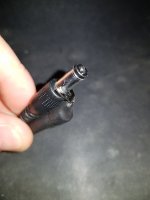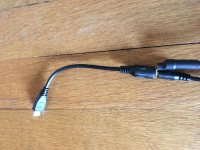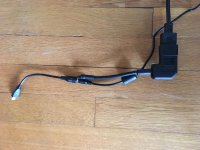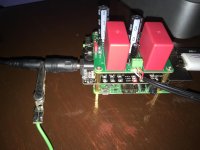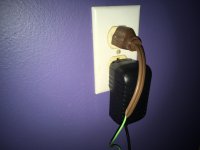Try grounding the outer barrel of the DC connector to safety earth. It needs to connect to earth at the same electrical outlet that the ifi wall wart is plugged into (see posts #79 & 89 in this thread). This made a difference in my setup when powering a Digione player. iFi sells the barrel connector for ~$12, but you have to go through the support pages and open a ticket.My experience with iFI ipower is that it does alter the SQ in a way that you lose the lower end. My setup is a 502 dac pro, powered separately from the pi. Initially I had ipower connected only to the dac and a usb charger for the pi. With that config, I could hear stronger bass notes. Yesterday I decided to get another ipower for the pi expecting better SQ but was sorely disappointed that it lost most of the lower end, lacking so much bass to a point that the music wasn't as enjoyable. It's unbelievable how much a power supply can alter the SQ of a rpi streamer. I'm gonna get the official power supply for the pi and see if it can balance out the highs and the lows.
Try grounding the outer barrel of the DC connector to safety earth. It needs to connect to earth at the same electrical outlet that the ifi wall wart is plugged into (see posts #79 & 89 in this thread). This made a difference in my setup when powering a Digione player. iFi sells the barrel connector for ~$12, but you have to go through the support pages and open a ticket.
This is good advice...made a huge difference in the noise floor with my Pi DAC. I have a single iPower going into an Allo Kali, which feeds power to the Pi below and my 1387 NOS DAC hat (by member Matt_Garman - highly recommended!!) above. I was very disappointed at first, because I had a substantial amount of background buzz (mildly annoying with speakers...bordering on intolerable for headphone use) until I grounded the barrel, which cut out like 95% of the noise. Now I am quite happy with it.
Last edited:
Try grounding the outer barrel of the DC connector to safety earth. It needs to connect to earth at the same electrical outlet that the ifi wall wart is plugged into (see posts #79 & 89 in this thread). This made a difference in my setup when powering a Digione player. iFi sells the barrel connector for ~$12, but you have to go through the support pages and open a ticket.
I raised a ticket to iFi, but looking at your picture in post #89 I'm still unsure how to connect it. Could you provide a picture of it hooked up?
iFi grounding adapter
Spade connector attached to the outer barrel and push onto the Pi power cord (dc to micro usb). Then use a standard mains cable-iec to connect to same outlet as the iFi wall wart.
I raised a ticket to iFi, but looking at your picture in post #89 I'm still unsure how to connect it. Could you provide a picture of it hooked up?
Spade connector attached to the outer barrel and push onto the Pi power cord (dc to micro usb). Then use a standard mains cable-iec to connect to same outlet as the iFi wall wart.
Attachments
Spade connector attached to the outer barrel and push onto the Pi power cord (dc to micro usb). Then use a standard mains cable-iec to connect to same outlet as the iFi wall wart.
Thanks Chris. I was reading https://ifi-audio.com/wp-content/uploads/data/Why does my audio system hum_.pdf
It states that only 1 equipment should be grounded. If my amp is grounded, then the rca cable should provide the grounding to the pi I guess
Sorry but I see a few electrically doubtful and also potentially unsafe PE situations. Why not do it "right" (and safe at the same time) ? Boards need to be mounted mechanically secured in a metal case and PSU's that may radiate garbage possible really need a rigid PE connection.
* This thread is about best 5V SMPS but please note that meanwhile there exist a few ready made 5V linear PSU's that may outperform SMPS or at least bring less secondary ill effects that some SMPS exhibit.
It is not that hard to use a metal case with PE connection filled with one or a few LDO ultra low noise PSU's (or SMPS) and have excellent results. Just cut off the original DC cord from the old switchers and connect them to the new LDO boards. Avoid the round DC connectors wherever you can and make rigid connections. In practice it is indeed better to have just one device where a connection is made between audio GND and PE. After many many earthing/grounding issues and solving them I think it is indeed the way to go. In this case with a source device I would only connect the housing to PE, I would leave audio GND floating. Normally the power amp has PE and audio GND connected either direct or "lifted".
When using a large enough metal case it is also possible to house the RPI/SBC and a SMPS/linear PSU in the same housing and have shielding and RF shielding at one and the same spot. Wiring is easier to do and shielding is then concentrated but may be harder to do. Way better linear/SMPS can be used that way. I have quite good experiences with Mean Well RS15-5 (as you see I use either linear or SMPS) which can deliver 3A. Note that its case is connected to PE. A metal case will thus be connect to PE so it may be necessary to mount it "floating" i.e. keep PE connection solely for this PSU and the housing and NOT connected to audio GND.
* This thread is about best 5V SMPS but please note that meanwhile there exist a few ready made 5V linear PSU's that may outperform SMPS or at least bring less secondary ill effects that some SMPS exhibit.
It is not that hard to use a metal case with PE connection filled with one or a few LDO ultra low noise PSU's (or SMPS) and have excellent results. Just cut off the original DC cord from the old switchers and connect them to the new LDO boards. Avoid the round DC connectors wherever you can and make rigid connections. In practice it is indeed better to have just one device where a connection is made between audio GND and PE. After many many earthing/grounding issues and solving them I think it is indeed the way to go. In this case with a source device I would only connect the housing to PE, I would leave audio GND floating. Normally the power amp has PE and audio GND connected either direct or "lifted".
When using a large enough metal case it is also possible to house the RPI/SBC and a SMPS/linear PSU in the same housing and have shielding and RF shielding at one and the same spot. Wiring is easier to do and shielding is then concentrated but may be harder to do. Way better linear/SMPS can be used that way. I have quite good experiences with Mean Well RS15-5 (as you see I use either linear or SMPS) which can deliver 3A. Note that its case is connected to PE. A metal case will thus be connect to PE so it may be necessary to mount it "floating" i.e. keep PE connection solely for this PSU and the housing and NOT connected to audio GND.
Last edited:
...I have quite good experiences with Mean Well RS15-5 (as you see I use either linear or SMPS) which can deliver 3A.....
I have tried these also but found that once you load them, just a little, their switching frequency drops into the audio range - I saw like 16 kHz if I recall correctly. Unloaded, spurioses was at 100k +...
Did you notice this?
//
Not that I remember and I like to think that I would have noticed that  I recently bought a few again, will test that. It does not fit in the "best" category but any better type can be used in the suggested topology. The RS15-5 is used by me in S905 based media players so for video. The original adapters as sold with these devices will die quite soon anyway and plugging in a device in a wall socket while playing video causes artefacts. I don't have this when I use the RS15-5. Hate to say it but for this goal they are "good enough". For my audio devices I tend to use ultra low noise LDO regs and Rcore transformers.
I recently bought a few again, will test that. It does not fit in the "best" category but any better type can be used in the suggested topology. The RS15-5 is used by me in S905 based media players so for video. The original adapters as sold with these devices will die quite soon anyway and plugging in a device in a wall socket while playing video causes artefacts. I don't have this when I use the RS15-5. Hate to say it but for this goal they are "good enough". For my audio devices I tend to use ultra low noise LDO regs and Rcore transformers.
Did you find a better performing replacement for the RS15-5 ?
Did you find a better performing replacement for the RS15-5 ?
Last edited:
Thanks for this advice jean-paul. It worked great in the case of my DAC transformer output - to - TA2020 amplifier. Originally my amp's power supply GND was floating, and my DAC transformer output's signal GND was earthed, and this worked OK, but the sound was a little recessed, or dull.In practice it is indeed better to have just one device where a connection is made between audio GND and PE. After many many earthing/grounding issues and solving them I think it is indeed the way to go. In this case with a source device I would only connect the housing to PE, I would leave audio GND floating. Normally the power amp has PE and audio GND connected
Now with the earthing regime reversed, much improved SQ especially in the treble ... and no hum.
Despite all the gurus trying to convince the world that SMPS is the best man invented we always seem to need a linear reg after them to make things as we want them to be
I somehow do believe in SMPS and had high hope for the Meanwells... but after I did the measurements I gave up on these as the last outpost for DC feed. Any other suggestion?
5V, 1/2A
//
The Meanwells I measured are not bad and better than specs. However mine seemed to hate chassis ground connected to 0V. I am not really surprised as they would themselves if it was OK and easy to do. Makes life hard sometimes. It seems to mean the safety ground can not be connected to signal ground. If anyone knows a trick let me know. The over current light goes on if attempted. If you look at the circuit class Y2 caps take the 0 and + to chassis. Knowing me I should have read the 20 page PDF a bit more carefully, nothing obvious was said.
I think if using the humble LM317 and a double size transformer a linear supply is hard to beat. No way if the full LM317 filtering is used can the noise of an SMPS beat it. Double size as it is likely the extra metal is a reasonable filter of mains junk. Not as good as some think I am sure. Usually the cost difference is minimal if going double size. SMPS by it's needs and nature must let more through.
I think if using the humble LM317 and a double size transformer a linear supply is hard to beat. No way if the full LM317 filtering is used can the noise of an SMPS beat it. Double size as it is likely the extra metal is a reasonable filter of mains junk. Not as good as some think I am sure. Usually the cost difference is minimal if going double size. SMPS by it's needs and nature must let more through.
The Meanwells I measured are not bad and better than specs. However mine seemed to hate chassis ground connected to 0V. I am not really surprised as they would themselves if it was OK and easy to do. Makes life hard sometimes. It seems to mean the safety ground can not be connected to signal ground. If anyone knows a trick let me know. The over current light goes on if attempted. If you look at the circuit class Y2 caps take the 0 and + to chassis. Knowing me I should have read the 20 page PDF a bit more carefully, nothing obvious was said.
I think if using the humble LM317 and a double size transformer a linear supply is hard to beat. No way if the full LM317 filtering is used can the noise of an SMPS beat it. Double size as it is likely the extra metal is a reasonable filter of mains junk. Not as good as some think I am sure. Usually the cost difference is minimal if going double size. SMPS by it's needs and nature must let more through.
Try connecting the safety ground to the 0v (outer barrel) after the Meanwell has been plugged into the ac, the fault condition should be bypassed as in this thread:
SMPS and grounding - Page 37 - UpTone Audio (Sponsored) - Computer Audiophile
The Meanwells I measured are not bad and better than specs. However mine seemed to hate chassis ground connected to 0V. I am not really surprised as they would themselves if it was OK and easy to do. Makes life hard sometimes. It seems to mean the safety ground can not be connected to signal ground. If anyone knows a trick let me know. The over current light goes on if attempted. If you look at the circuit class Y2 caps take the 0 and + to chassis. Knowing me I should have read the 20 page PDF a bit more carefully, nothing obvious was said.
Audio GND and PE shouldn't be connected directly in source devices (AFAIK only done in the UK) but I wonder why yours gave a short circuit like behaviour. Do you have the schematic of the RS15-5? I connect the PE of the RS15-5 to the PE connection of the IEC inlet and case is also connected to PE. I leave audio GND floating to avoid nasty things. PE is good for safety but not always good for audio. Connecting audio GND straight to PE is an exaggerated safety measure as the case is already connected to PE. As with many british built devices it causes more problems than it solves. Ground loops are common.
I think if using the humble LM317 and a double size transformer a linear supply is hard to beat. No way if the full LM317 filtering is used can the noise of an SMPS beat it. Double size as it is likely the extra metal is a reasonable filter of mains junk. Not as good as some think I am sure. Usually the cost difference is minimal if going double size. SMPS by it's needs and nature must let more through.
Sorry but LM317 has no place anymore in audio when we have LT3042 and LT3045. Way better specs and ULDO. Less heat, less noise, less of everything and more of the good things
* The suggestion to make PE connection to audio GND while the device is energized is plain bad practice. Any fault condition will reflect on the person doing this action ! Don't do stupid things and enjoy your hobby longer.
Last edited:
I will study that. I did some tests of LM317. I had a big surprise. Quite a bit of reading if you can be bothered.
Simple Voltage Regulators Part 2: Output Impedance
Simple Voltage Regulators Part 2: Output Impedance
Yes I know this. It was 2004 then. LM317 has had a good fruitful life but times are changing. Many have tweaked and tuned LM317 and it is/was a plain good regulator. In this day and age of energy saving LDO regs should be used but till recently they were noisy. That has changed with the creation of these LT regs.They offer ULDO (so less generated heat) AND lower noise specs than LM317. Please note that transformers with lower secondary voltage must be chosen when using ULDO instead of LM317 !
Try out LT3042 (0.2 A) or LT3045 (0.5 A) and be surprised. They can be used in parallel for more current. Since performance is very good I allow for pass transistors for higher output current (at the penalty of slightly worse performance) but this simple solution is not short circuit proof. I can live with that. I already made a few hints in various threads on a certain 15 Euro costing ready made Ebay PCB with it so I won't repeat that. Some members here offer PCB's and/or ready built devices of higher quality but at a way higher price.
Try out LT3042 (0.2 A) or LT3045 (0.5 A) and be surprised. They can be used in parallel for more current. Since performance is very good I allow for pass transistors for higher output current (at the penalty of slightly worse performance) but this simple solution is not short circuit proof. I can live with that. I already made a few hints in various threads on a certain 15 Euro costing ready made Ebay PCB with it so I won't repeat that. Some members here offer PCB's and/or ready built devices of higher quality but at a way higher price.
Last edited:
- Status
- This old topic is closed. If you want to reopen this topic, contact a moderator using the "Report Post" button.
- Home
- Amplifiers
- Power Supplies
- Best 5V SMPS ?
